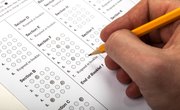Exams are used in schools across the world to measure a student's level of knowledge on a particular subject or subjects. Passing exams with high marks while in high school can increase a student's chances of being accepted to a good college, and performing well while in college will increase their chance of landing a good job. While these advantages are obvious to students, the advantages that exams offer students and educators go far beyond these commonly thought of examples.
General Advantages
Exams encourage students to reflect upon and study their coursework, thereby improving student retention of information. The exams offer schools and school districts with solid metrics to assess the strengths and weaknesses of their programs so that they may adjust resources to provide additional support accordingly. Testing can also help educators identify particular students who may be struggling with their work and need extra assistance.
Oral and Written Exams
Oral and written exams can be used when grading subjects that may not present one single answer to a given question. They are also extremely useful in the teaching of a foreign language, where the instructor can gauge conversational capabilities and reading comprehension of individual students. These exams allow teachers to better understand the thought process of their students and adjust their teaching accordingly.
Locally-Developed Exams
Exams which are developed by a particular learning institution can quickly produce metrics for a given class, program, or school. These tests are especially helpful for testing the effectiveness of different teaching methods within a new program or field of study for a school. Since they are locally developed, the exams can be custom written to match only the point of interest of the faculty and advisory board of the school that is producing it.
Standardized Testing
Standardized testing can be implemented and distributed to large communities very quickly. These tests objectively measure student knowledge on a wide variety of topics and grade them all using a standardized grading system. Since there is no variation in testing or grading, and the tests are often given to large samples of students, the results can be used to gauge overall quality of education within a state or nation.
Related Articles
Writer Bio
Richard Kyori has been writing professionally since 2006. He has been teaching design and technology courses at colleges and universities since 2005. Kyori holds a Bachelor of Arts in art history from Boston University and is working toward a Master of Architecture.











